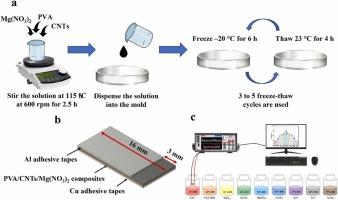基于PVA/CNTs/Mg(NO3)2复合材料的人工智能自供电湿度传感器,用于智能应用
IF 3.7
1区 化学
Q1 CHEMISTRY, ANALYTICAL
引用次数: 0
摘要
本研究介绍了一种基于PVA/CNTs/Mg(NO3)2复合材料的柔性自供电湿度传感器的创建和全面评估,该传感器采用夹芯结构设计,采用铝和铜胶带电极,通过冻融技术合成,以提高机械稳定性和灵活性。该传感器利用聚乙烯醇(PVA)的亲水性和可降解特性、碳纳米管(CNTs)的导电途径以及硝酸镁(Mg(NO3)2)的高离子电导率来实现高效的吸湿和离子迁移,产生稳定的电压输出,电压输出范围为11 - 97% %。通过XRD、SEM、FTIR和水接触角测试,材料表征证实了复合材料结构完整、形貌均匀、亲水性可控。电化学分析表明,复合材料在97 % RH下的峰值电压为0.6 V,响应/恢复时间分别为12和16 s,滞后最小(3.5 % RH),持续稳定性超过500 min。该传感器在180 min内通过复合材料的水溶解证明了可回收性,尽管性能降低了12.1% %(从0.58 V降至0.51 V),并且在触摸传感、高达8 mm的非接触检测以及区分裸手与戴手套的手相互作用等应用中具有多功能性。机器学习与门控循环单元(GRU)模型的集成实现了0.0001的MSE和0.9991的R²,通过利用传感器的动态电压响应提高了湿度预测的准确性。这些发现表明,PVA/CNTs/Mg(NO3)传感器是一种稳健、环保的可穿戴和环境监测平台,对可持续传感技术具有重要意义,并为进一步优化回收效率和预测建模提供了机会。本文章由计算机程序翻译,如有差异,请以英文原文为准。

AI-enabled self-powered humidity sensors based on PVA/CNTs/Mg(NO3)2 composites for smart applications
This research introduces the creation and thorough assessment a flexible self-powered humidity sensor based on a PVA/CNTs/Mg(NO3)2 composite, designed in a sandwich configuration with aluminum and copper adhesive tape electrodes, synthesized via the freeze-thaw technique to enhance mechanical stability and flexibility. The sensor leverages the hydrophilic and degradable properties of polyvinyl alcohol (PVA), the conductive pathways of carbon nanotubes (CNTs), and the high ionic conductivity of magnesium nitrate (Mg(NO3)2) to achieve efficient moisture adsorption and ion migration, generating stable voltage outputs with range of 11–97 %. Material characterization through XRD, SEM, FTIR, and water contact angle measurements confirms the composite structural integrity, uniform morphology, and controlled hydrophilicity, while electrochemical analysis reveals a peak voltage of 0.6 V at 97 % RH and response/recovery times of 12 and 16 s, respectively, with minimal hysteresis (3.5 % RH) and sustained stability over 500 min. The sensor demonstrates recyclability through water dissolution of the composite within 180 min, albeit with a 12.1 % performance reduction (from 0.58 V to 0.51 V), and versatility in applications such as touch sensing, non-contact detection up to 8 mm, and differentiation of bare versus gloved hand interactions. Integration of machine learning, with the Gated Recurrent Unit (GRU) model achieving an MSE of 0.0001 and R² of 0.9991, enhances humidity prediction accuracy by leveraging the sensor dynamic voltage responses. These findings establish the PVA/CNTs/Mg(NO3) sensor as a robust, eco-friendly platform for wearable and environmental monitoring, with significant implications for sustainable sensing technologies and opportunities for further optimization in recycling efficiency and predictive modeling.
求助全文
通过发布文献求助,成功后即可免费获取论文全文。
去求助
来源期刊

Sensors and Actuators B: Chemical
工程技术-电化学
CiteScore
14.60
自引率
11.90%
发文量
1776
审稿时长
3.2 months
期刊介绍:
Sensors & Actuators, B: Chemical is an international journal focused on the research and development of chemical transducers. It covers chemical sensors and biosensors, chemical actuators, and analytical microsystems. The journal is interdisciplinary, aiming to publish original works showcasing substantial advancements beyond the current state of the art in these fields, with practical applicability to solving meaningful analytical problems. Review articles are accepted by invitation from an Editor of the journal.
 求助内容:
求助内容: 应助结果提醒方式:
应助结果提醒方式:


